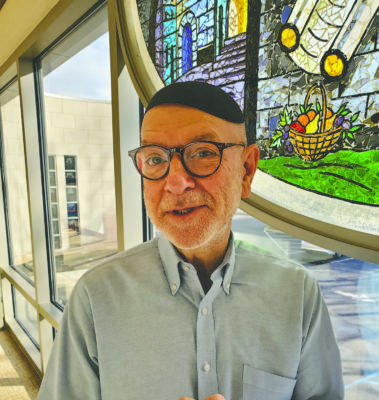
(Photo courtesy of Rabbi Rank)
The High Holy Days are rapidly approaching. The sound of the shofar—a ram’s horn—will return once again. However, the long, still sound might be a tad different.
The echo created by the shofar might last even longer this year. That’s because synagogues across Long Island will have fewer people in attendance due to the COVID-19 pandemic. The High Holy Days begin with Rosh Hashanah at sunset on Friday, Sept. 18, and the clock is ticking.
Some synagogues are imposing a specific limit to the number of people who can attend the services this year, while others are streaming services on Zoom and even hosting multiple of the same services throughout the High Holy Day season.
“Challenges, challenges,” Rabbi Perry Raphael Rank from the Midway Jewish Center said. “There will be many.”
New York Governor Andrew Cuomo said in June that houses of worship could only open at 25 percent capacity. That’s a major issue for small Jewish congregations, which need a quorum of 10 people to conduct a complete service.
U.S. District Court Judge Gary Sharpe in late June said the state cannot impose a lower capacity limit for houses for worship compared to other places.
“We need to create a sense of community while people are seated 10 feet apart,” Rabbi Rank said. “We need to create the warmth and joy that lies at the heart of our community while reminding people not to shake hands, hug or kiss. We need to honor people while suspending almost 95 percent of all honors typically distributed as we do not want people touching the Torah or the Ark.”
Rabbi Anchelle Perl from Congregation Beth Sholom Chabad in Mineola is doing things much differently. It’s a time for his congregation to get creative.
The Chabad in Mineola will have a pair of Shabbat morning services on Rosh Hashanah, with one service from 7 to 11 a.m. and the other from 11:30 a.m. to 1:30 p.m. Both services will include a sermon, with the latter serving as a “highlighted service.” Likewise will be the case on Yom Kippur, which begins on Sunday, Sept. 27.
“I want people to do exactly what they are comfortable doing,” Rabbi Rank said. “I will not persuade someone to attend services nor encourage them to stay home, unless I feel they really should not be at services. Wherever they choose to be, is a personal decision and I’m okay with that. My job is to be sure that wherever they are, they are able to welcome in the New Year with the self-reflection this time of year demands and with the blessings they and their family deserve.”
All congregations in the area are mandating masks and observing social distancing practices. However, the idea of limiting the number of people to a service is essentially unheard of.
Congregation Beth Tikvah in Wantagh will offer multiple services, each being shorter than usual, essentially staggering them. In between each service, sanitizing will take place. The congregation will also live stream each service for people who cannot physically attend.
It’s yet another challenge for synagogues. Due to the rise in anti-Semitism, Cuomo mandated an increased amount of security at the houses of worship in 2019. That security will likely continue in 2020, with anti-Semitic incidents still on the rise. Through the first five months of the year, anti-Semitic incidents reached a 40-year high in New York State.
Throughout the pandemic, synagogues have faced many halachic—Jewish law—questions that they might have never dealt with. Among them is the idea of live streaming services for more observant congregations.
Reform congregations have streamed services for several years, but it is forbidden in conservative and orthodox synagogues due to Judaism’s stance of not using electronic devices on Shabbat and holy days. Since this is a scenario that is unheard, compromises have to be made. Rabbinic authorities have been more lenient with this rule because of the capacity limit the governor is mandating, as well as the fact that it is recommended that elderly congregants do not attend services.
“Since June 6, we have conducted services in the sanctuary and have also begun to stream those services,” Rabbi Rank said. “The decision to stream was not made lightly as we recognized that it would be compromising some aspects of Jewish law. But in the end, it was an ethical decision we needed to make, in as much as we were actively discouraging certain people from attending. So the question became, for us, how do we on the one hand discourage our membership from attending while not providing some alternative in the meantime. And, at that point, it was important for us to stream the services and that’s what we have been doing.”



















